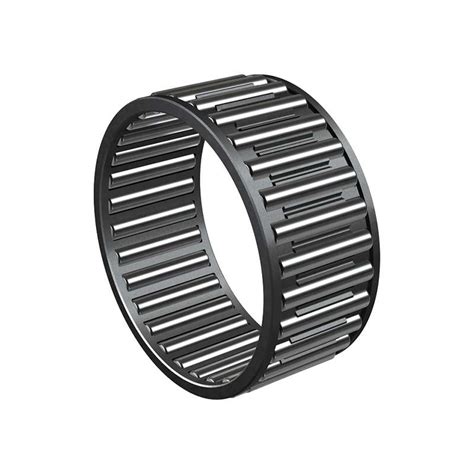Needle Roller Bearings: A Comprehensive Guide to Precision Engineering
Needle roller bearings, ubiquitous in various industries, play a pivotal role in reducing friction and minimizing wear, thereby enhancing the efficiency and longevity of machinery. This article aims to provide an in-depth understanding of needle roller bearings, exploring their types, applications, benefits, and proper handling practices.
Types of Needle Roller Bearings
Needle roller bearings are primarily classified into three main types:
-
Drawn cup needle roller bearings: Available in open and closed end configurations, these bearings feature a thin, cylindrical outer race and a needle cage filled with needle rollers.
-
Needle thrust bearings: Designed to accommodate axial loads, these bearings comprise a washer-type race and a needle cage assembly.

-
Combined needle roller bearings: A hybrid design that combines the features of radial needle roller bearings and thrust bearings, offering simultaneous support for radial and axial loads.

Applications of Needle Roller Bearings
Needle roller bearings find widespread use in a plethora of industrial and automotive applications, including:
- Machine tools
- Gearboxes
- Engines
- Pumps
- Conveyors
- Robotics
Benefits of Needle Roller Bearings
The employment of needle roller bearings offers numerous advantages:
-
Compact design: Their small diameter and low cross-section make them ideal for space-constrained applications.

-
High load capacity: Despite their compact size, needle roller bearings exhibit exceptional load-carrying capacity.
-
Low friction: The line contact between the needle rollers and raceways results in reduced friction and heat generation.
-
High speed performance: Needle roller bearings can operate at high speeds, making them suitable for demanding applications.
-
Durability: Their robust construction ensures extended service life under harsh operating conditions.
Proper Handling of Needle Roller Bearings
To ensure optimal performance and longevity, needle roller bearings require proper handling during installation and maintenance.
-
Cleanliness: Always handle bearings with clean gloves or tools to prevent contamination.

-
Lubrication: Use the appropriate lubricant, quantity, and method recommended by the manufacturer.
-
Mounting: Ensure proper alignment and press fit during bearing mounting.
-
Storage: Store bearings in a dry, controlled environment to prevent corrosion.
Effective Strategies for Needle Roller Bearing Application
-
Use the correct bearing type: Selecting the most suitable bearing type for the specific application's load, speed, and environmental conditions is crucial.
-
Proper lubrication: Adhering to the manufacturer's recommended lubrication schedule is essential to minimize friction and extend bearing life.
-
Prevent contamination: Employ measures to keep contaminants, such as dirt, water, and debris, away from the bearings.
-
Regular inspections: Periodic inspections can help detect potential issues early on, allowing for timely maintenance.
Humorous Stories and Lessons Learned
Story 1:
A mechanic was tasked with replacing a faulty needle roller bearing in an engine. However, due to a mix-up, he accidentally installed a bearing with a different cage material. As a result, the bearing seized up within hours, causing extensive damage to the engine. Lesson: Double-check part numbers and ensure proper compatibility before installation.
Story 2:
A manufacturing plant was experiencing premature failures of needle roller bearings in their conveyor system. Upon investigation, it was discovered that the bearings were being lubricated with an incompatible grease, leading to rapid wear and tear. Lesson: Use the correct lubricant specified by the bearing manufacturer.
Story 3:
A robotics engineer was designing a robotic arm for a delicate precision assembly task. To minimize friction, they opted for needle roller bearings in the arm's joints. However, they overlooked the need for dust seals, resulting in the bearings becoming contaminated and causing inaccuracies in the robot's movements. Lesson: Pay attention to environmental factors and employ protective measures to shield bearings from contamination.
Common Mistakes to Avoid
-
Overloading: Exceeding the bearing's load capacity can lead to premature failure.
-
Improper mounting: Misalignment or inadequate press fit can cause bearing damage or reduced performance.
-
Insufficient lubrication: Starving the bearing of lubrication can result in increased friction, wear, and failure.
-
Contamination: Exposure to dirt, water, or corrosive substances can shorten bearing life.
-
Ignoring maintenance: Neglecting regular inspections and maintenance can lead to undetected issues and costly failures.
Step-by-Step Approach to Needle Roller Bearing Installation
-
Prepare the housing: Clean and inspect the bearing housing to ensure it is free of debris and damage.
-
Lubricate the bearing: Apply the appropriate lubricant to the bearing's rolling elements and raceways.
-
Insert the bearing: Carefully insert the bearing into the housing, ensuring proper alignment.
-
Press fit the bearing: Use a suitable tool to press the bearing into place.
-
Install the retaining ring: If required, secure the bearing with a retaining ring to prevent axial displacement.
Pros and Cons of Needle Roller Bearings
Pros:
| Advantage |
Description |
| Compact design |
Ideal for space-constrained applications |
| High load capacity |
Can withstand significant loads despite their small size |
| Low friction |
Reduces heat generation and improves efficiency |
| High speed performance |
Suitable for high-speed applications |
| Durability |
Robust construction ensures extended service life |
Cons:
| Disadvantage |
Description |
| Limited axial load capacity |
Not suitable for applications with heavy axial loads |
| Sensitivity to contamination |
Susceptible to damage from dirt and other contaminants |
| Noise |
Can generate noise at high speeds |
| Cost |
May be more expensive than other bearing types for certain applications |
Conclusion
Needle roller bearings play a vital role in countless industrial and automotive applications, enabling smooth operation, high efficiency, and extended equipment life. By understanding the different types, benefits, and proper handling practices, engineers and technicians can optimize the performance of needle roller bearings in their designs and applications.

